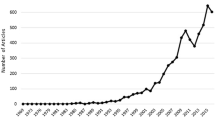Abstract
Coauthorship links actors at the micro-level of scientists. Through electronic databases we now have enough information to compare entire research disciplines over time. We compare the complete longitudinal coauthorship networks for four research disciplines (biotechnology, mathematics, physics and sociology) for 1986–2005. We examined complete bibliographies of all researchers registered at the national Slovene Research Agency. Known hypotheses were confirmed as were three new hypotheses. There were different coauthoring cultures. However, these cultures changed over time in Slovenia. The number of coauthored publications grew much faster than solo authored productions, especially after independence in 1991 and the integration of Slovenian science into broader EU systems. Trajectories of types of coauthorship differed across the disciplines. Using blockmodeling, we show how coauthorship structures change in all disciplines. The most frequent form was a core-periphery structure with multiple simple cores, a periphery and a semi-periphery. The next most frequent form had this structure but with bridging cores. Bridging cores consolidate the center of a discipline by giving it greater coherence. These consolidated structures appeared at different times in different disciplines, appearing earliest in physics and latest in biotechnology. In 2005, biotechnology had the most consolidated center followed by physics and sociology. All coauthorship networks expanded over time. By far, new recruits went into either the semi-periphery or the periphery in all fields. Two ‘lab’ fields, biotechnology and physics, have larger semi-peripheries than peripheries. The reverse holds for mathematics and sociology, two ‘office’ disciplines. Institutional affiliations and shared interests all impact the structure of collaboration in subtle ways.
Similar content being viewed by others
References
Barabási, A.L., Albert, R., Jeong, H.: Mean-field theory for scale-free random networks. Physica A. 272, 173–187 (1999)
Barabási, A.L., Jeong, H., Neda, Z., Ravasz, E., Schubert, A., Vicsek, T.: Evolution of the social network of scientific collaborations. Phys. A: Stat. Mech. Appl. 311(3-4), 590–614 (2002)
Batagelj V., Mrvar A.: Analysis and visualization of large networks. In: Jünger, M., Mutzel, P. (eds) Graph drawing software, pp. 77–103. Springer, Berlin (2003)
Corley E.A., Boardman P.C., Bozeman B.: Design and management of multi-institutional research collaborations: Theoretical implications from two case studies. Res. Policy 35, 975–993 (2006)
Crane D.: Invisible colleges: diffusion of knowledge in scientific communities. University of Chicago Press, Chicago (1972)
de Nooy W., Mrvar A., Batagelj V.: Exploratory social network analysis with pajek. Cambridge University Press, Cambridge (2005)
Doreian P., Batagelj V., Ferligoj A.: Generalized Blockmodeling. Cambridge University Press, Cambridge (2005)
Erjavec, T., Ignat, C., Pouliquen, B., Steinberger, R.: Massive multi-lingual corpus compilation: acquis communautaire and totale. In: Proceedings of the 2nd Language and Technology Conference, Poznan, pp. 32–36 (2005)
Ferligoj A., Kronegger L.: Clustering of attribute and/or relational data. Metodološki Zvezki. Adv. Methodol. Stat. 6(2), 135–153 (2009)
Ferligoj A., Doreian P., Batagelj V.: Positions and roles. In: Scott, J., Carrington, P. (eds) Sage Handbook of Social Network Analysis, pp. 434–446. Sage Publications, Newbury Park (2010)
Garfield E.: Citation indexes for science. Science 122, 108–111 (1955)
Garfield E.: Citation indexing: Its theory and application in science, technology, and humanities. ISI Press, Philadelphia (1979)
Gómez I., Fernández M.T., Sebastián J.: Analysis of the structure of international scientific ooperation networks through bibliometric indicators. Scientometrics 44(3), 441–457 (1999)
Hicks D.M., Katz J.S.: Where is science going?. Sci. Technol. Hum. Values 21(4), 379–406 (1996)
Kretschmer H.: Patterns of behaviour in coautorship networks of invisible colleges. Scientometrics 40(3), 579–591 (1997)
Kretschmer H.: A new model of scientific collaboration Part 1. Theoretical approach.. Scientometrics 46(3), 501–518 (1999)
Kretschmer H., Hoffmann U., Kretschmer T.: Collaboration structures between german immunology institutions, and gender visibility, as reflected in the web. Res. Eval. 15(2), 117–126 (2006)
Kuhn T.S.: The Structure of Scientific Revolutions. University of Chicago Press, Chicago (1962)
Kundra R., Kretschmer H.: A new model of scientific collaboration Part 2. Collaboration of patterns in Indina medicine. Scientometrics 46(3), 519–528 (1999)
Lambiotte R, Panzarasa P: Communities, knowledge creation, and information diffusion. J. Informetr. 3(3), 180–190 (2009)
Laudel G: Collaboration, creativity and rewards: why and how scientists collaborate. Int. J. Technol. Manag. 22, 762–781 (2001)
Moody J: The structure of a social science collaboration network. Am. Sociol. Rev. 69, 213–238 (2004)
Newman M.E.J.: Coauthorship networks and patterns of scientific collaboration. Proc. Natl. Acad. Sci. USA. 101(Suppl. 1), 5200–5205 (2004)
Perianes-Rodríguez A., Olmeda-Gómez C., Moya-Anegón F.: Detecting, identifying and visualizing research groups in co-authorship networks. Scientometrics 82(2), 307–319 (2010)
Price D.S.: Little science, big science and beyond. Columbia University Press, New York (1963)
Price D.S.: Networks of scientific papers. Science 149, 510–515 (1965)
Wagner C., Leydesdorff L.: Network structure, self-organization, and the growth of international collaboration in science. Res. Policy 34(10), 1608–1618 (2005)
Yasuhiro Y., Yoshiko O.: Patterns of scientific collaboration between Japan and France. Inter-sectoral Analysis Using Probabilistic Partnership Index. Scientometrics 68, 303–324 (2006)
Ziberna A.: Generalized blockmodeling of valued networks. Soc. Netw. 29(1), 105–126 (2007)
Author information
Authors and Affiliations
Corresponding author
Rights and permissions
About this article
Cite this article
Kronegger, L., Ferligoj, A. & Doreian, P. On the dynamics of national scientific systems. Qual Quant 45, 989–1015 (2011). https://doi.org/10.1007/s11135-011-9484-3
Published:
Issue Date:
DOI: https://doi.org/10.1007/s11135-011-9484-3




